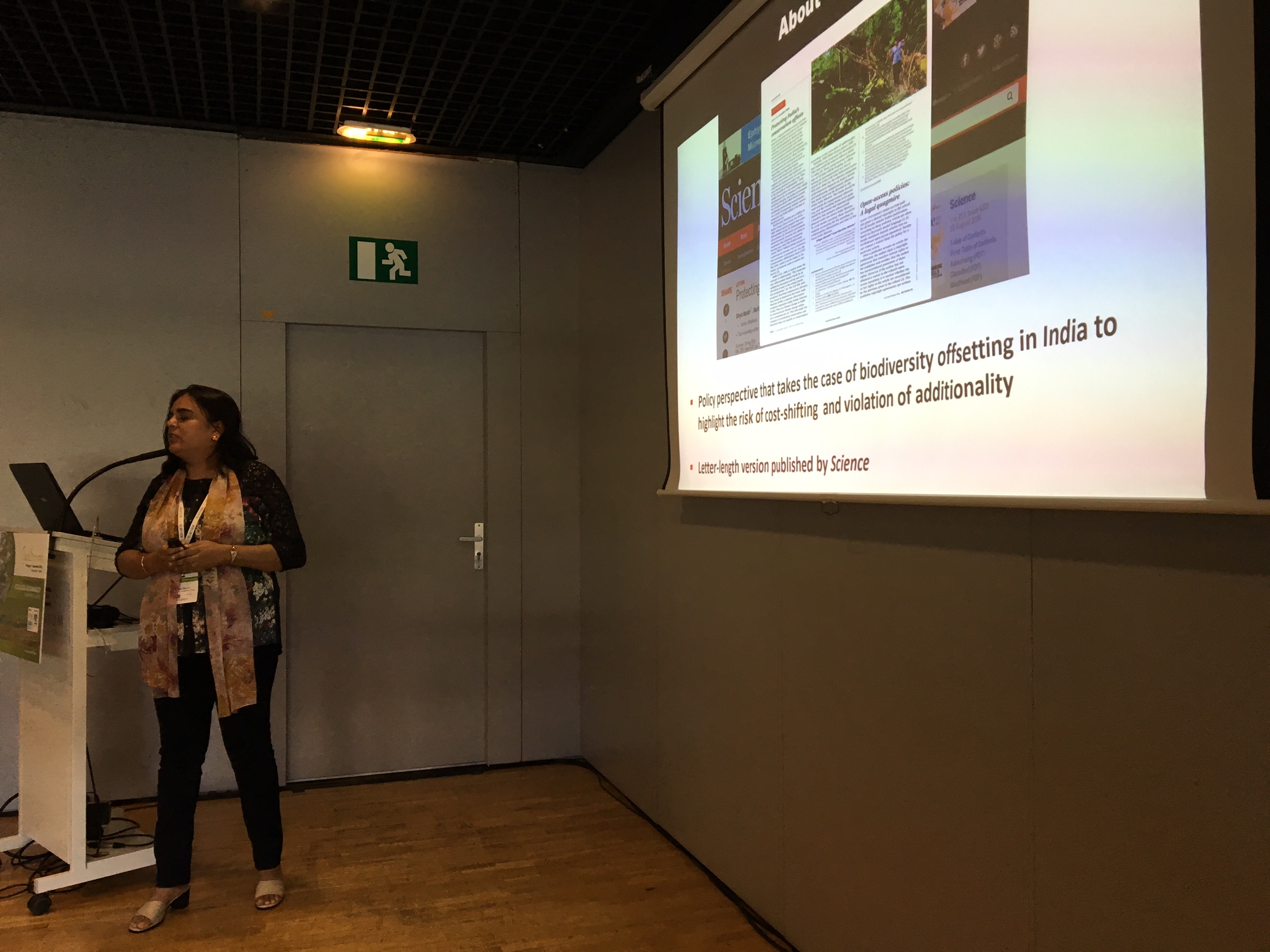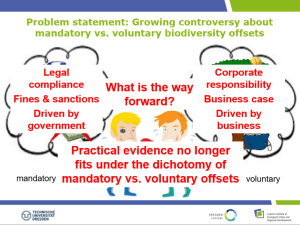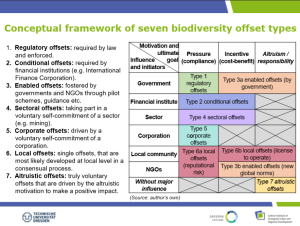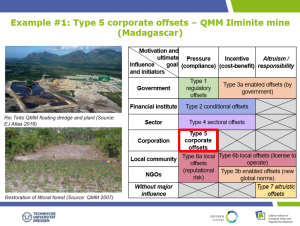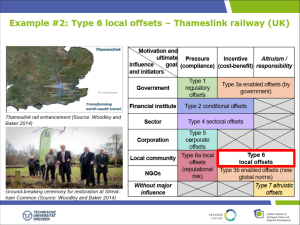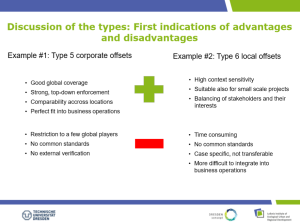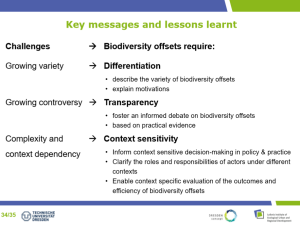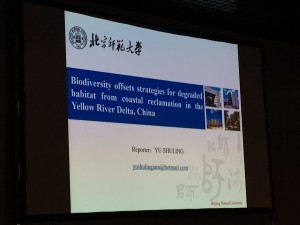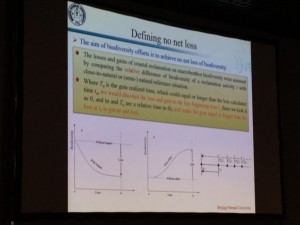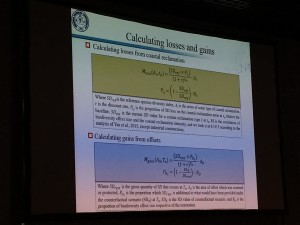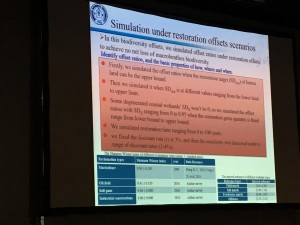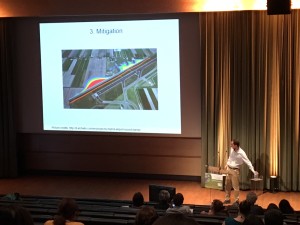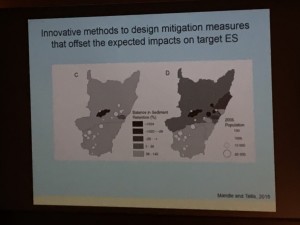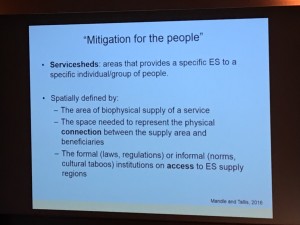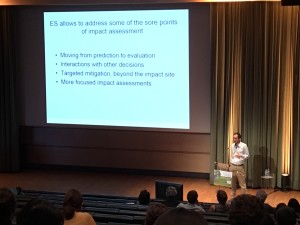 As I had promised earlier, I am sharing with you some impressions and presentations from our biodiversity offsets session at the recent EcoSummit in Montpellier. After the general session description and line-up of speakers, find below the abstract and presentation for each of the speakers (including a few photographs).
As I had promised earlier, I am sharing with you some impressions and presentations from our biodiversity offsets session at the recent EcoSummit in Montpellier. After the general session description and line-up of speakers, find below the abstract and presentation for each of the speakers (including a few photographs).
About the session: European perspectives and global challenges on achieving no net loss of biodiversity in the context of development
With biodiversity being lost at unprecedented rate, there is growing concern on how to mitigate the unavoidable impacts of development projects. Alongside with the promotion of goals of ‘no net loss’ or ‘net gain’, biodiversity offsets are increasingly used to counterbalance these impacts. While offset frameworks have been put in place in several countries worldwide (e.g. Germany, the US, Australia, Canada, Brazil), the subject has risen onto the political agenda of the European Union in the past years, most notably via the proposed No Net Loss Initiative, but also in several member states (e.g. France, Spain, the UK and Sweden). This session aims to bring together the latest developments from science, policy and practice from EU member states and international experience in addressing the global challenges raised by biodiversity offset policies and their implementation, including social, economic and political aspects as well as technical and scientific aspects.
Line-up of speakers
| 16:30–16:45 | [S08.28] Innovative methods and organizational approaches for improved implementation of the French No Net Loss policy F. Quetier*1, A-C. Vaissiere1 1Biotope, France, 2Université de Montpellier, France |
| 17:00–17:15 | [S08.30] Farmers’ preferences on implementing biodiversity offsets on arable lands A.C. Vaissière*1, L. Tardieu2,3, F. Quétier4, S. Roussel5 1Université de Montpellier (UM), France, 2INRA, France, 3AgroParisTech, France, 4Biotope, France, 5Université Paul Valéry Montpellier 3 (UPVM3), France |
| 17:15–17:30 | [S08.31] Compensation or co-optation: Violation of additionality in compensatory afforestation in India D. Narain*1, M. Maron1 1Environmental Management Centre, India, 2The University of Queensland, Australia |
| 17:30–17:45 | [S08.32] Urban area impacts on the biodiversity: How to take into account the local/in-situ and the ex-situ impacts? N. Schiopu*1, E. Guegan2, T. Lecomte3, T. Lavisse1, V. Hilaire1, A. Wolff4, B. Clement5 1Université Paris Est, CSTB, France, 2SIVaTRU, France, 3Centre de Recherche Mines de Douai, France, 4École Nationale Supérieure des Mines de Saint-Étienne (EMSE), France, 5LEHNA, Ecole Nationale des Travaux Publics de l’Etat (ENTPE), France |
| 17:45–18:00 | [S08.33] Biodiversity offsets between regulation and voluntary commitment: Development of a typology of voluntary biodiversity offsets using an expert and internet based research approach M. Darbi IOER Leibniz Institute of Ecological Urban and Regional Development, Germany |
Innovative methods and organizational approaches for improved implementation of the French No Net Loss policy
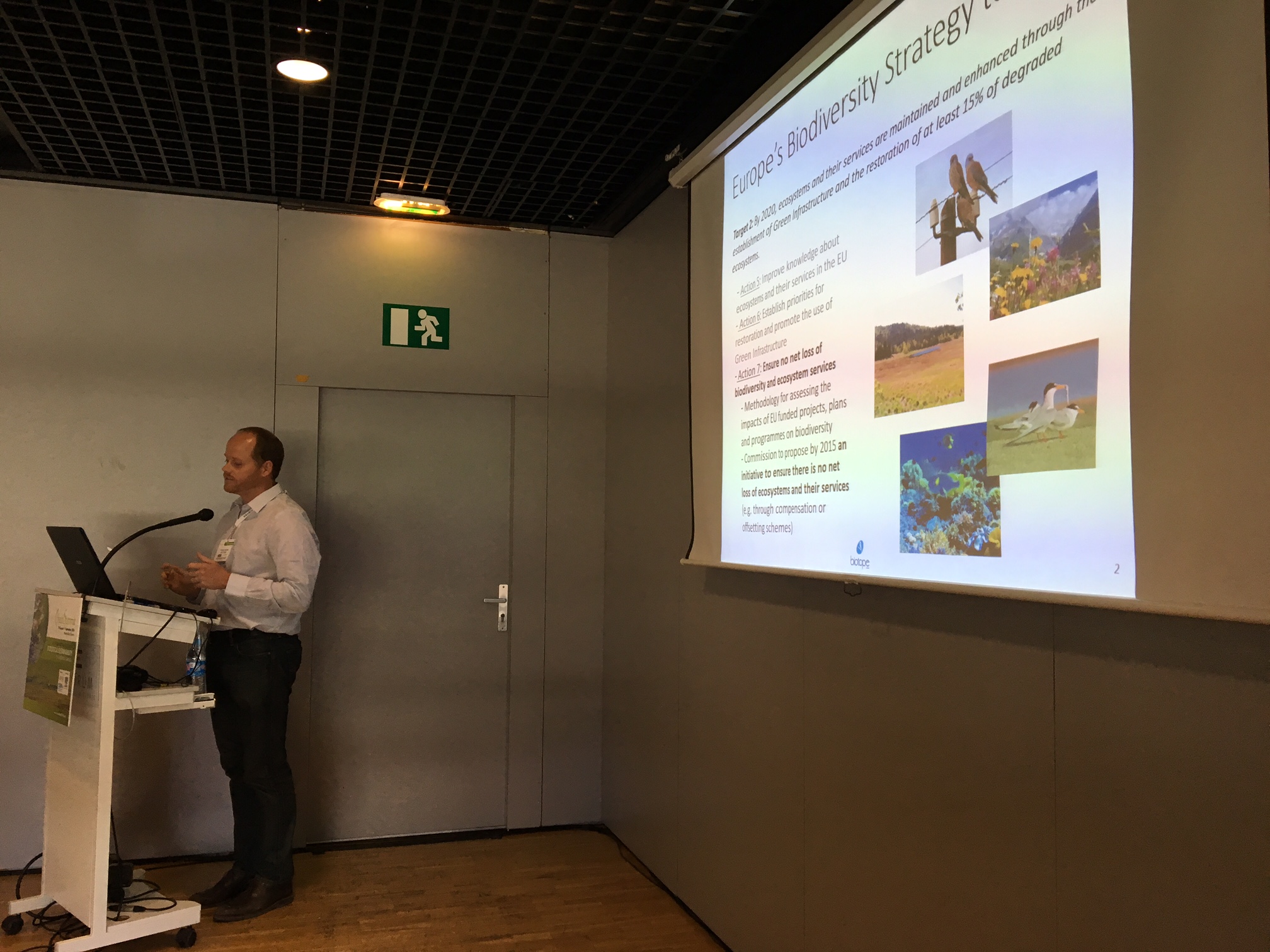 Fabien Quétier & Anne-Charlotte Vaissière, France
Fabien Quétier & Anne-Charlotte Vaissière, France
When development projects generate impacts on biodiversity that could not be sufficiently avoided or reduced, offsets must be designed and implemented to effectively and fully compensate for the residual loss of biodiversity. International best practice indicates that biodiversity offsets must achieve no net loss (NNL) of biodiversity, or preferably a net gain (NG). In 2012, the French government published guidance on implementing the mitigation hierarchy, with NNL as an implicit goal. The French NNL policy was established through an integrative approach to various thematic regulations covering protected species and certain types of habitats such as wetlands, forests, and vegetation types listed in the EU Habitats Directive. Changes to the procedures for obtaining derogations to the protection of certain species (in 2007) and to the EIA process (in 2012) offered a productive context in which to develop the policy.
There are considerable technical and organizational challenges to designing and implementing biodiversity offsets. Losses and gains must be assessed and compared, to demonstrate NNL, in-kind and on the basis of targeted loss-gain metrics impacted for species, habitats, etc., offset feasibility must be assessed, to ensure they can land and expertise can be accessed for the implementation and long-term management. To address this challenge, a dedicated methodology was developed and applied to a new railway project in Southern France. Losses and gains were measured in “offset units”, calculated as quality-hectares per species, and then integrated into a common framework to determine the amounts of each multi-species habitat that had to be restored (and how) to achieve NNL. The method was successfully applied thanks to a continuous engagement with stakeholders, and was shown to enable a rigorous, transparent and participatory treatment of biodiversity impacts from development.
Designing and sizing offsets is only a first step, and actual implementation often remains an important hurdle. A number of projects in France have had to address this challenge. In the example above, contracts with farmers enables the developer to enhance the biodiversity value of farmland to meet the NNL goal. In practice, such approaches are akin to Payments for Ecosystem Services, and raise similar challenges for their long-term success. Operations similar to “habitat-banking” have been developed, under the impetus of a national pilot program, whereby offset sites are identified and managed by private or public entities, or through private-public partnerships. We analyse these against an international benchmark, to identify some of the remaining gaps in the institutional framework which needs to be established for the NNL goal to be achievable. A draft law on biodiversity currently being discussed in the French Parliament makes this analysis particularly policy-relevant.
Link to presentation: Quétier_&_Vaissiere_EcoSummit2016_Session45
Farmers’ preferences on implementing biodiversity offsets on arable lands
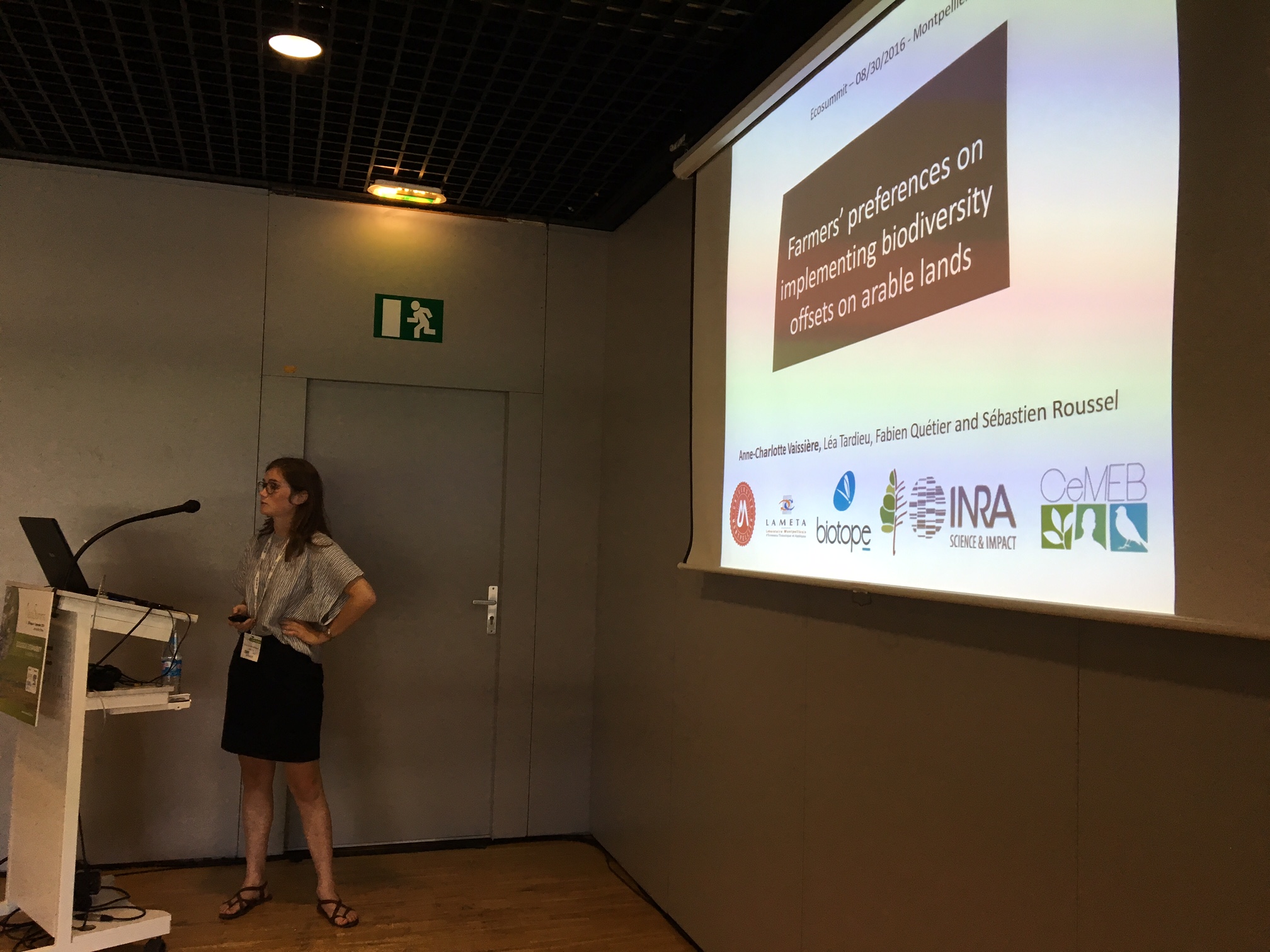 Anne-Charlotte Vaissière et al., France
Anne-Charlotte Vaissière et al., France
Biodiversity Offsetting (BO) is supposedly aimed at achieving No Net Loss (NNL) of biodiversity in the context of development. Agricultural landscapes sometimes have low levels of biodiversity, and the ecological restoration or enhancement of arable lands through BO may show ecological gains. However, farmers’ implementing BO on their arable land, against payments by developers, remains a controversial topic that has been little studied and discussed in the scientific literature. One could wonder if the implementation of long term BO contracts, satisfying restrictive conditions for ecological performance, can match farmers’ preferences and constraints. Our study aims at providing key factors explaining the decision by farmland owners to sign a BO contract, with those contracts satisfying the NNL imperative. Our works are grounded in economics applied to conservation biology. In order to capture the farmers’ preferences, we conducted a Choice Experiment (CE) study at the scale of a French agricultural region. Four attributes, describing different scenarios of BO measures, were selected: the management plan of the actual ecological measures for ecosystem enhancement, the length of the contract, the annual payment, and, in an innovative way, a monetary bonus for additional ecologically relevant contractual terms. Preliminary results suggest a trade-off between biodiversity conservation requirements and socio-economical stakes. Among the attributes having a significant effect on farmers’ utility, the ones that better explain the willingness (or reluctance) to sign BO contracts are the length of the contract and the annual payment. Further, a spatial analysis linked to answers regarding additional ecologically relevant contractual terms through the monetary bonus, should also be conducted.
Compensation or co-optation: Violation of additionality in compensatory afforestation in India
Developing countries are home to world’s remaining biodiversity and are ‘hotspots for conservation priorities’. In rapidly growing countries such as India, there is a constant tug-of-war between development and conservation. ‘Development or Conservation’, however, is not necessarily a binary choice. Compensatory biodiversity conservation seeks to balance the two, by mitigating the impacts of development on biodiversity. For compensatory conservation to be valid, it should be additional to any pre-existing conservation commitments of the government.
Stipulated by India’s Forest Conservation Act (FCA), 1980, compensatory afforestation is a prerequisite for approval of development projects on forestland. Thirty-five years have passed since the enforcement of FCA but government after government has failed to put in place an institutional mechanism to utilize the compensatory afforestation payments collected from project proponents. Monies to the tune of Rs. 38,000 crore (and accrued interest of Rs. 6000 crore) are lying unutilized. The Compensatory Afforestation Fund (CAF) Bill, 2015 tabled by the new government seeks to rectify this situation.
The FCA, 1980 explicitly requires compensatory afforestation to be additional. However, the new CAF Bill stipulates diverting compensatory afforestation funds towards afforestation commitments that the government has made under the Convention on Biological Diversity (CBD) and the United Nations Framework Convention on Climate Change (UNFCCC). This amounts to ‘cost shifting’ because compensatory afforestation funds will substitute the conservation funding already pledged by the government. The co-optation of compensation funds, in effect, cancels the mitigation benefits that were intended to be achieved by the initial payments.
The stipulations of the proposed CAF bill clearly violate FCA’s requirement of additionality. ‘Fair and plausible’ counterfactuals based on international commitments and separate accounting of compensatory afforestation and other afforestation programmes will go a long way in conveying ‘genuine intentions’ of meeting international commitments as well as mitigating the impact of development on biodiversity.
Link to presentation: Narain and Maron 2016
Further read:
Urban area impacts on the biodiversity: How to take into account the local/in-situ and the ex-situ impacts?
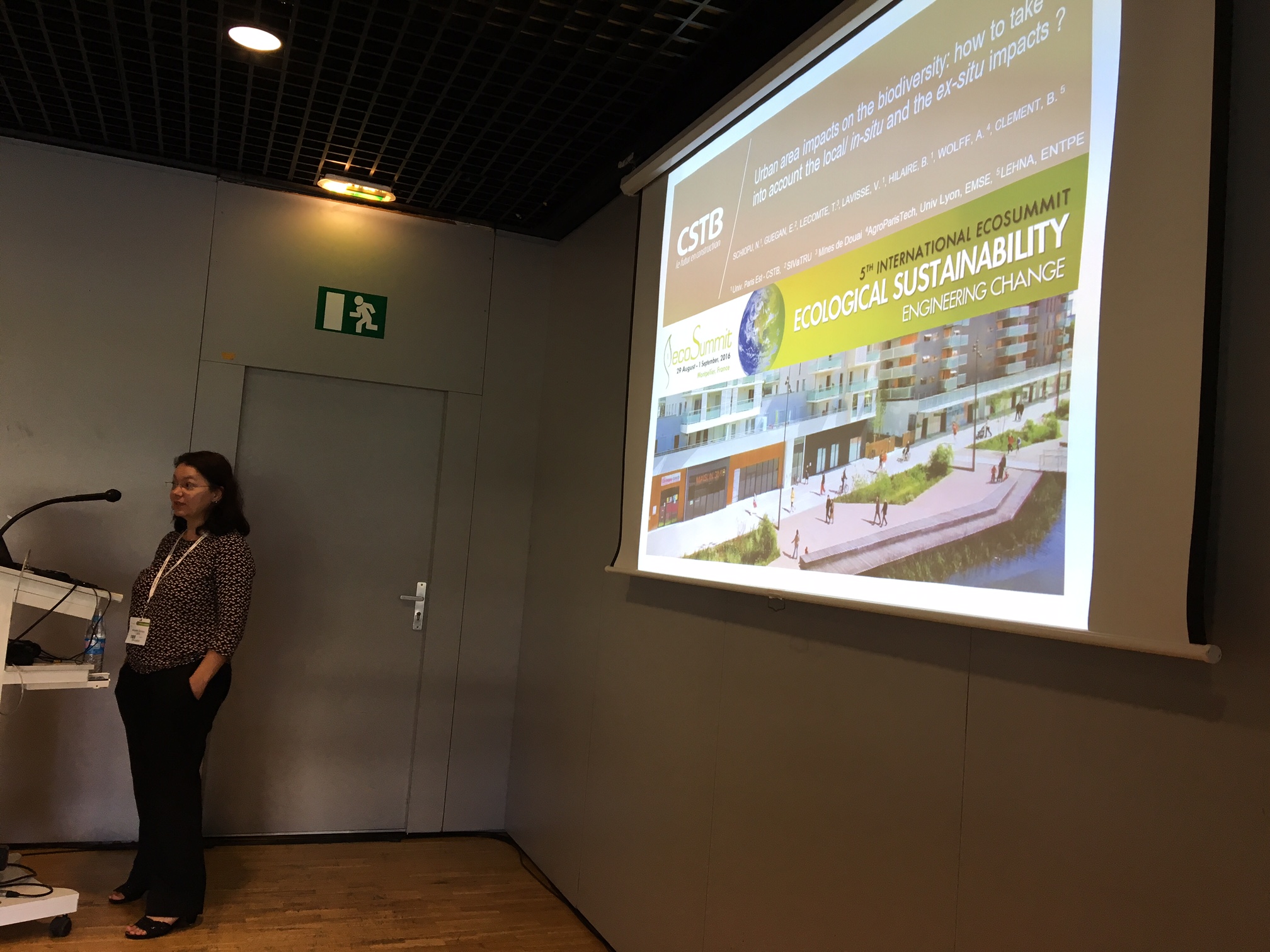 Nicoleta Schiopu et al., France
Nicoleta Schiopu et al., France
For a few years, the Life Cycle Assessment (LCA) methodology has been the main approach used for the environmental assessment in the construction field. Nevertheless, assessment of the built environment impacts on biodiversity is still a difficult issue in LCA of buildings and urban area. Major challenges are that impacts on biodiversity need to be assessed within a specific biogeographic context and the complexity of ecosystems needs to be considered. In the same time, LCA practitioners call for easy-to-use assessment routines. The local environmental impacts assessment of a construction project is generally based on the environmental impact studies. Nevertheless, this kind of approach does not take into account the ex-situ impacts on biodiversity caused for example by the raw materials extraction necessary for the construction products. Finding balanced solutions that adequately represent ecosystem complexity and that are still relatively easily applicable is essential to improve environmental assessment methods and tools. The goal of this work is to propose a method aiming at taking into account both the in-situ and ex-situ impacts of a construction project on biodiversity. To achieve this goal, first we identified the main anthropogenic pressures on biodiversity (climate change, eutrophication, land use, etc.) and how the built environment contributes to these pressures, during all phases of its life cycle. Then, methods were identified in the literature or developed in order to assess each pressure. A proof of concept tool for calculating impacts on biodiversity was developed and used for a case study that enabled the comparison of two scenarios for a construction project. The results are presented as muticriteria graph: one indicator for each pressure of the built environment on the biodiversity. They also could be presented as a global score after a weighting step (less transparent but considered as easier to use for the decision process).
Link to presentation: S08.32_EcoSummit2016_URBAN_BIODIV_NicoletaSCHIOPU
Biodiversity offsets between regulation and voluntary commitment: Development of a typology of voluntary biodiversity offsets using an expert and internet based research approach
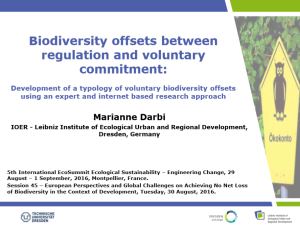 Marianne Darbi, IOER Dresden, Germany
Marianne Darbi, IOER Dresden, Germany
The discussion about voluntary vs. mandatory offsets has risen to particular attention with the planned No Net Loss initiative of the EU and the envisaged introduction of a mandatory compensation scheme at EU level. However, biodiversity offsets are far more complex than this distinction of two types of biodiversity offsets implies. Consequently, the aim of this study was to develop a refined typology with regard to the voluntariness of biodiversity offsets. To this end, four consecutive steps have been applied:
- Deduction of an impressionistic classification of types,
- Derivation (and reduction) of relevant attributes/criteria for voluntariness from the
theory, - Substruction of the underlying attribute space and combinations of attributes, and
- Transformation (rectification) of the impressionistic types and analysis of meaningful
correlations.
As a result, a typology with seven types has been built:
- Regulatory offsets: required by law and enforced
- Conditional offsets: required by financial institutions (e.g. International Finance
Corporation) - Enabled offsets: fostered by governments and NGOs through pilot schemes, guidance
etc. - Sectoral offsets: take part in a voluntary self-commitment of a sector (e.g. mining)
- Corporate offsets: resulting from a voluntary self-commitment of a corporation
- Local offsets: single offsets, that are most likely developed at local level in a consensual process
- Altruistic offsets: truly voluntary offsets that are driven by the altruistic motivation to make a positive impact
The state of the scientific knowledge and the practical evidence explored throughout this study encourage the analysis (and use of) of the various forms of voluntary biodiversity offsets, in particular with regard to the evaluation of their outcome in terms of effectiveness and efficiency. This can help to contribute to an informed debate about biodiversity offsets and how they can be delivered in practice.
Link to presentation: 08.33_Typology of voluntary biodiversity offsets_Marianne Darbi_Ecosummit 2016
Impact mitigation and biodiversity offsets in other sessions
There were also a few presentations relevant to the field of impact mitigation and biodiversity offsets in other sessions.
Investigating the inclusion of ecosystem services in biodiversity offsetting
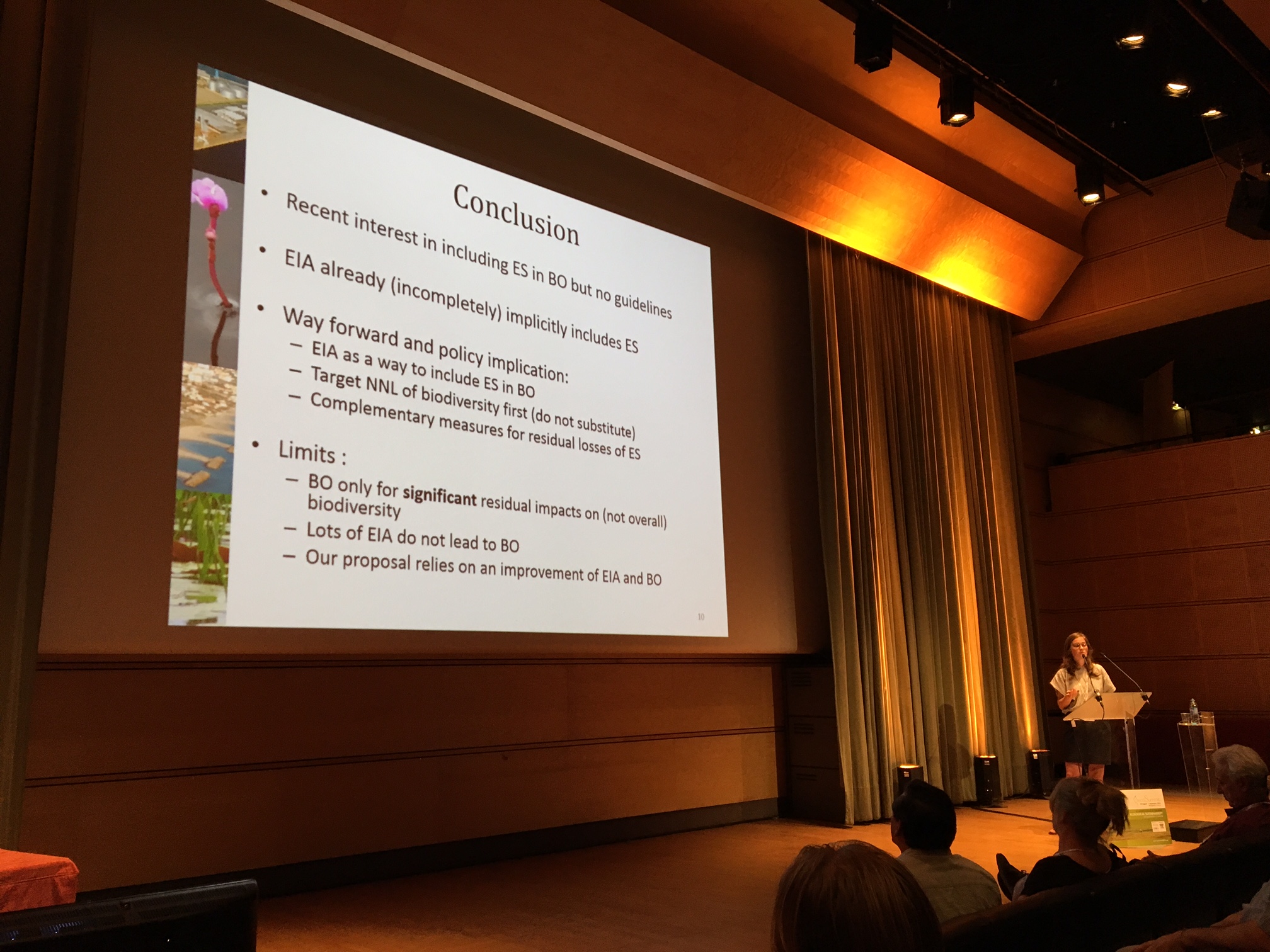 C. Jacob, A.-C. Vaissiere, A. Bas, C. Calvet
C. Jacob, A.-C. Vaissiere, A. Bas, C. Calvet
In response to growing international interest regarding the consideration of ecosystem services (ES) in the framework of biodiversity offsetting (BO) and the current lack of guidelines on the subject, we investigated the potential inclusion of ES in BO, highlighting the risks and opportunities. Our argument is premised on the assumption that a practical link already exists between the two and that most of the tools required to make this approach operational are available. Building on that, we propose a logical way to integrate ES at each step of the implementation of the mitigation hierarchy within Environmental Impact Assessments and provide details on the links with existing practice. In our proposal, the inclusion of ES is presented as a way to complement current approaches based on the assessment of habitats/species/ecological functions rather than to replace them. The aim is to minimize ES losses as well as biodiversity losses at both the avoidance and reduction steps of the mitigation hierarchy. We argue that measures proposed to offset biodiversity losses, in addition to respecting ecological performance standards, should equally be chosen to minimize residual losses of ES. The latter require offsetting by different types of complementary measures, which might include nature-based, human-based or financial solutions. Implementing these recommendations as good practice should strengthen the weight of biodiversity (as it is a key provider of ES), demonstrate consideration of social equity, and result in better acceptance of development projects and the measures proposed to offset them.
Link to presentation: Jacob et al_Ecosummit 2016
Further read:
- Jacob C., Vaissière A-C., Bas A., Calvet C., (2016). Investigating the inclusion of ecosystem services in biodiversity offsetting. Ecosystem Services, 21, 92–102.
- Jacob C., Pioch S., Thorin S., (2016). The effectiveness of the mitigation hierarchy in environmental impact studies on marine ecosystems: A case study in France.Environmental Impact Assessment Review, 60, 83–98.
- Bas A., Jacob C., Hay J., Pioch S., Thorin S., (2016). Improving marine biodiversity offsetting: A proposed methodology for better assessing losses and gains.Journal of environmental management, 175, 46–59.
Optimizing biodiversity offsets strategies for degraded habitat from coastal reclamation
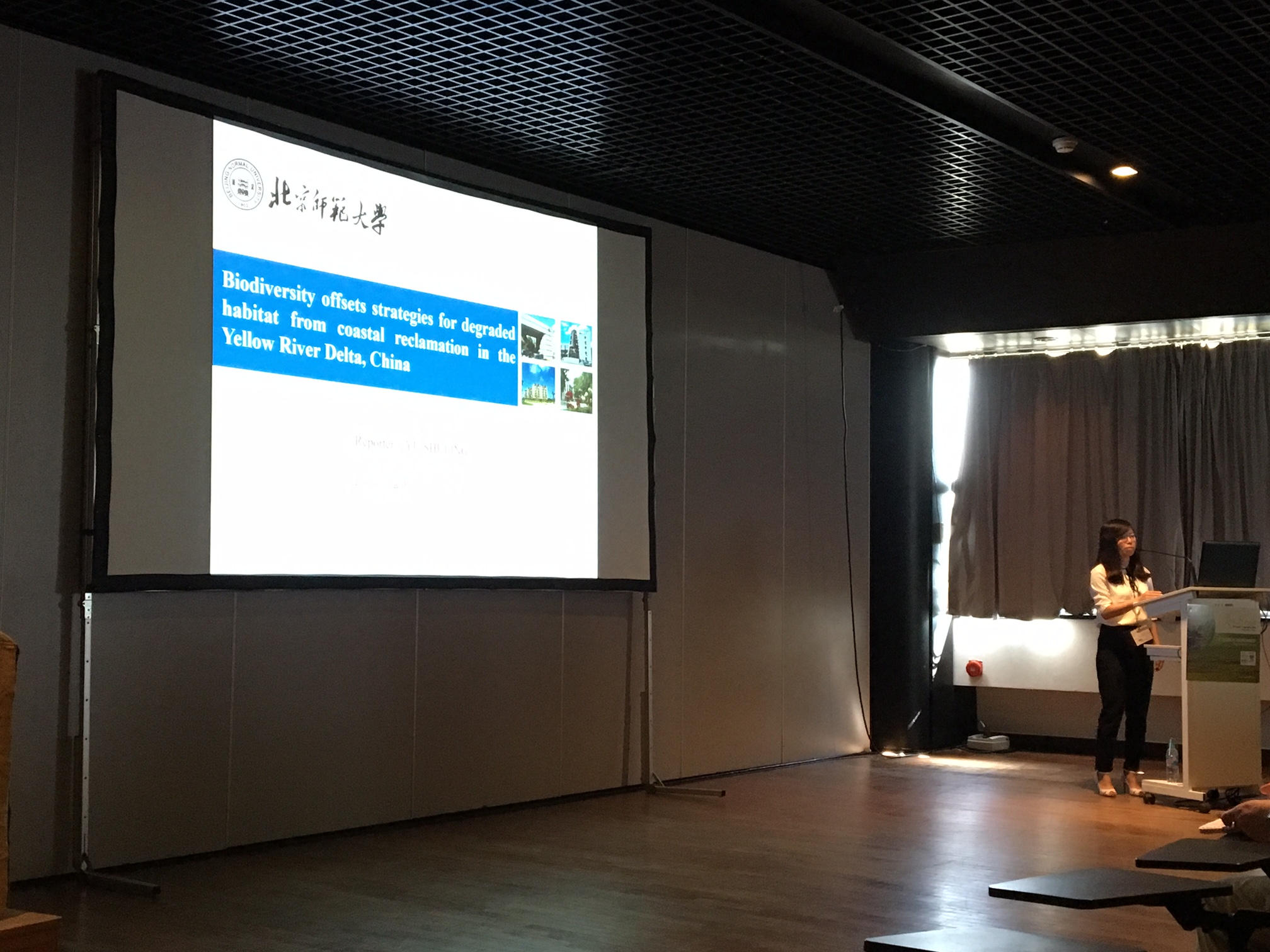 S.L. Yu*, B.S. Cui, G.X. Song, X. Ma, Y.X. Zou, X.J. Shao, Beijing Normal University, China
S.L. Yu*, B.S. Cui, G.X. Song, X. Ma, Y.X. Zou, X.J. Shao, Beijing Normal University, China
With the increasing reclamation activities, it has resulted in a great loss of coastal wetlands. Harm native species by altering attributes of biodiversity and coastal habitats. Biodiversity offsets have been widely used in compensating the impacts with equivalent gains elsewhere. However, choosing metrics for measuring ecological equivalency in losses and gains have been a big theoretical problem. The focus has been mainly on a single aspect of biodiversity, such as threatened species populations or habitats, which can’t represent biodiversity value and key ecosystem functions equivalence. Here we propose the use of species diversity index as an optimizing metric to measure the equivalency between coastal reclamation losses on biodiversity value and the gains elsewhere. The model proposed is based on data collected by previous researches on the species diversity of macrobenthos in different coastal reclamation types in Yellow River Delta, China, which is the typical taxonomic group in coastal wetlands. Within each study, calculated values for species diversity index (SD) for different coastal reclamation types were compared with the natural or close-to-natural state, taken as the reference situation. SD values among different coastal reclamation types were standardized, and the SD losses were calculated. Then degenerated coastal wetlands which have been barren were chosen to restore or rehabilitate in-kind or out-of-kind to compensate the losses with the gains, and simulated the offsets ratio under different values of counterfactual scenarios and different SD gross quantity that would be provided as the offset to the different coastal reclamation, time lags in realizing was taken into account. The proposed biodiversity offsets strategies for degraded habitat from coastal reclamation mainly focus on the minimum offset ratios, and the basic properties of how, where and when. No net loss is likely to be feasible when the restoration offset ratio is great than or equal to the corresponding offset ratio. Our study has important implications for biodiversity conservation and the ecological restoration of coastal wetlands in face of the reclamation activities.
Ecological engineering and restoration for marine ecosystems: limits and opportunities for their implementation within the mitigation hierarchy
C. Jacob, A. Buffard, S. Pioch, S. Thorin
The mitigation hierarchy is increasingly used in environmental policies as a way to reconcile economic development and biodiversity conservation. The principle of the mitigation hierarchy consists in the avoidance, reduction and offset of environmental impacts arising from development projects by providing ecological gains through conservation or restoration actions. Most of the research on this subject to date has focused on terrestrial ecosystems. Here, we investigate the relevance of ecological restoration (ER) and ecological engineering (EE) approaches applied to various marine ecosystems as components of a mitigation strategy. Through a literature review of existing ER and EE techniques for marine and coastal ecosystems (e.g., “green” marine construction norms, bioremediation, restoration of seagrass meadows, macro-algae beds, and coral reefs), and a discussion of their efficacy and feasibility, we highlight the current limits and opportunities related to the implementation of the mitigation hierarchy within the marine environment. We discuss the use of either ER or EE according to the level of equivalence being sought between the losses caused by a development project and the gains of the offset measure. We then propose guidelines for practitioners to better discriminate between different techniques according to the requirements of the mitigation hierarchy. This should help to clarify to what extent we have the capacity to mitigate environmental impacts of economic activities on marine biodiversity.
Ecosystem services for impact assessment
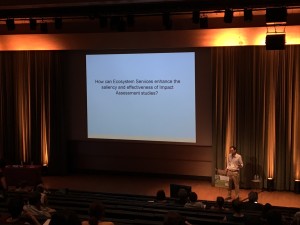 D. Geneletti* University of Trento, Italy
D. Geneletti* University of Trento, Italy
Impact assessment is the ‘the process of identifying the future consequences of a current or proposed action’ (IAIA, 2009). At its heart, impact assessment aims to provide information for decision-making. Integrative impact frameworks are being proposed to include the effects of development on ecosystem services and human wellbeing, along with more traditional biodiversity conservation issues. Recent research and practice has shown the emerging interest in this area, but also the many open challenges. This presentation aims to provide an overview research and practice in the field of integrating ecosystem services in impact assessment of projects, plans and policies. By making reference to relevant case studies, the presentation will describe how ecosystem services information can be mainstreamed in different impact assessment types to improve their salience and effectiveness. Finally, some of the issues and challenges in contemporary practice and research will be discussed.

